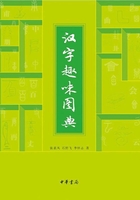
“廾”部字
部首分析

甲骨文像双手有所捧持或操作之形。人有左右两手,虽然一只手也能做事,但只要可能,人们总是习惯两手一起做事,而且有些事必须两手一起合作才能完成,因此,古文字中有很多包含左右两手形的构件。这些构件,到楷书发生较大变化,有的变作“廾”,有的变作“ ”,有的变作“大”,还有的变作两个其他构件,如“丞”“承”字中的左右两个构件。以“廾”为部首的字大都与手的动作有关,如“开弄戒弃弊”;也有的“廾”构件是相近字形简化的结果。如“异”。
”,有的变作“大”,还有的变作两个其他构件,如“丞”“承”字中的左右两个构件。以“廾”为部首的字大都与手的动作有关,如“开弄戒弃弊”;也有的“廾”构件是相近字形简化的结果。如“异”。


古鈢文字形像双手取去门关之形,本义就是“开门”。后来双手形构件变作“廾”,汉字简化时又将“门”构件简省。
应用:
● 本义:
开门。泛指打开。例:开锁;开箱子;开口。
● 引申为:
1. 打通,开辟。例:开路;开矿。
2. 展开,分离。例:开花;扣开了。
3. 解冻。例:七九河开。
4. 发动或操纵。例:开枪;开车。
5. 开办。例:开工厂;开医院。
6. 开始。例:开学;开工。
7. 解除。例:开戒;开禁;开释。
8. 开除。例:双开。


甲骨文像两手持玉摩挲玩赏之形。
应用:
● 本义:
用手玩弄。例:低头弄莲子;弄古董;不要弄火。
● 引申为:
1. 搞,做,办。例:弄明白;弄糊涂。
2. 想办法取得。例:弄个谋生之道。
3. 耍弄,玩弄。例:弄权术;弄巧成拙;弄假成真;捉弄;愚弄。


甲骨文像双手持戈之形。
应用:
● 本义:
防备,戒备。例:戒严;戒心;戒备。
● 引申为:
1. 戒除。例:戒烟;戒毒。
2. 禁止做的事情。例:开戒;杀戒;戒忌;戒律。


甲骨文像双手将簸箕中的婴儿丢弃之状。简化为“弃”。
应用:
● 本义:
抛弃,丢弃。例:舍弃;遗弃;弃权。


甲骨文像头上顶戴着东西,而两手捧扶之形。简化为“异”。
应用:
● 本义:
顶在头上。后来写作“戴”。
● 引申为:
1. 新奇的,特别的。例:奇花异草;优异;异味;异香。
2. 惊奇,觉得奇怪。例:怪异;诧异;惊异。
3. 不同的。例:异同;异口同声;异议。
4. 其他的,别的。例:异乡;异国;异族。
5. 分开。例:离异。